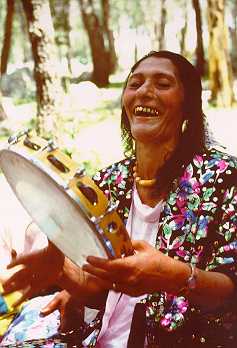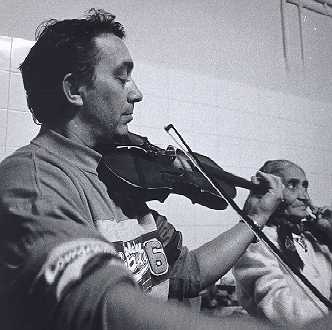2. The Roma as mediators of culture:
tradition and innovation in music.
More than an ethnic group that can be further
divided in sub-ethnic groups, the Roma are a cast of artisans and
outsiders who act as specialists in the interpretation of
traditions - be they Turkish, Albanian, Serbian, Macedonian, and
still others - and cultural mediators. This point may well evoke
a continuity between the populations that left India in the
Middle Ages and the present groups of European and Near and
Middle Eastern Gypsies. The Roma have probably contributed to the
formation of the present cultural heritage of the areas in which
they have settled, and particularly to what one might call its
'Islamic' components. As a result of their origins, and their
professional musical activities in all territories subject to
Turkish domination, the Roma have exerted a considerable
influence on musical life (10). I believe that these specialised interpreters of
traditions (and specifically of musical traditions) played a
considerable role in the importing into Western Europe of
instruments and musical forms of Near and Middle Eastern origin,
a role that is much more significant, in my view, than modern
organology has acknowledged thus far. This point is especially
relevant to the repertoires and to the objects of both ritual and
domestic music.
| As far as ceremonial and
military repertoires are concerned, together with the
trumpets and the drums with which these are played,
theories that relate their diffusion into the West to the
Crusades and to the military conflict between Islam and
Christianity seem credible. On the other hand, this
explanation appears much less convincing with regard to
other musical instruments and forms of expression that
still today are the attributes of some Gypsy groups (11). It should also be noticed that the areas which
have acted as a filter for the introduction into the West
of musical forms and instruments do correspond only
occasionally with the borderline between Islam and
Christianity. These include areas that are heavily
populated by Gypsies, particularly in the south of Spain
and the Balkans. The constant renovation of the
instruments of the Roma tradition, as well as the quick
distribution within their community of state-of-the-art
technology, clearly indicate the current vitality of the
cultural role of the Roma Khorakhané.  Tambourin and voice (.wav file 191 kb) Tambourin and voice (.wav file 191 kb)
|
 Tambourin player,
Palermo - Photo N.
Staiti
|
Cellular phones, VCRs, and satellite antennae
are the new instruments of an ancient orality. Likewise,
saxophones, drum-sets, and electronic keyboards have substituted
almost completely the surle and the daouli, the
oboes and the two-skin drums that the Roma themselves once spread
across the Balkans (see Brandl 1996; Pettan 1996; Silverman 1996;
Rice 1982). While visiting some of the families that reside in
Italy I have often had the opportunity to witness the video
recording of a party that took place in the home of some relative
who had remained in Yugoslavia. In these parties, the dances were
frequently accompanied by surle and daouli.
 Khorakhané modern orchestra at
wedding. St.Caterina Camp, Bologna - Photo: N. Staiti
|
The derogatory and ironic
comment which is frequently heard in this case is that
some kind of 'peasant celebration' is taking place,
although it was very clear both to them and myself that
the 'peasants' in question are in fact the Roma and their
relatives. The reason for this comment is that the
celebration is considered to be consist of 'the old
stuff', by people who oppose change and who are ignorant
of the ways of the world, i.e., like peasants. More
recently introduced instruments (and here I exclude the
accordion, which became common in Kosovo and Montenegro
at the beginning of the twentieth century) represent in
some way a restoration of tradition and a coherent,
dynamic innovation of its codes, not a complete departure
from them. |
Electronic keyboards, allowing for non-diatonic
scales, permit the performance of traditional Eastern European
melodic patterns.
The glissando obtainable with the manual
changer of pitch allows the imitation of the slight changes of
tuning that the player produces on the surle with his lips, and
can do so employing a far wider range than the old instrument
would permit (12), thus
emphasising the peculiarities of this musical language (see
Pettan 1992).
The extremely tight membranes of two small
drums of the drum-set imitate perfectly the sound of the
darabouk, i.e., the goblet drum that is still used, sometimes, as
a portable substitute for the drum-kit.
 Drums: Baró Khoró - Great Dance (.wav file 156 kb)
Drums: Baró Khoró - Great Dance (.wav file 156 kb)
The handy keyboard of the synthesiser, the
sticks andthe elastic and strong synthetic membranes of the
drum-kit, the system of keys on the saxophone, the mixer, the
microphones, and the amplifiers allow a speed of phrasing, a
precision of execution, a volume and a balance among the various
voices of the orchestra that used to be unthinkable.
 Saxophone: fragment of
Taskim - (.wav file 190 kb)
Saxophone: fragment of
Taskim - (.wav file 190 kb)
All these factors enrich and renew the language
of tradition in a most striking way. Some fundamental aspects of
this language however are preserved, such as modes, rhythmic
structures, phrasing, melodic materials, the relationship between
fixed structures and improvisation, and the formulaic character
of the repertory. Most important, the traditional openness to
innovation and to the mixing of forms and material is preserved.
| This attitude has always
been a distinct character of the Roma people, one that
particularly stands out in a world which is essentially
agricultural and pastoral, and generally conservative.
Today the Roma people continue to play the same role of
mediators of culture that centuries ago led them to
contribute to the importation into the Balkans, from
South and East, of surle, daouli, darabouk,
tambourines, and long-necked lutes, as well as to
contribute probably to the diffusion of the violin among
Eastern European peasants. The
use of these instruments today is, ironically, considered
'peasant-like', although it is still remembered and
practiced on some occasions. In general, though,
keyboards replace oboes, precisely because the Roma
remain faithful to their role as mediators.
|
 Dassikhané violin player. Sasso
Marconi, Bologna
Photo N. Staiti
|
Therefore, we can identify the specific
character of Roma culture in their manner of interpretation and
in their role of bearers and preservers of tradition, rather than
in distinct traditions that belong exclusively to them. The one
significant exception of the language seems to underline further,
rather than to negate, their particular role as outcasts and,
simultaneously, as bearers of culture within the wider society.
Forward | Back | Rom main page | References


